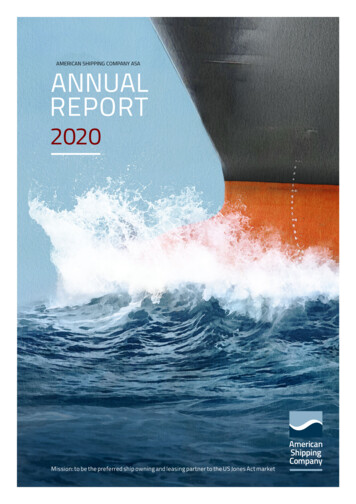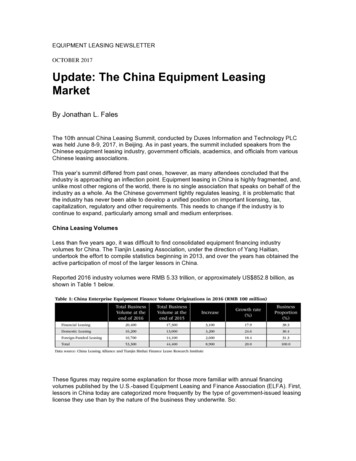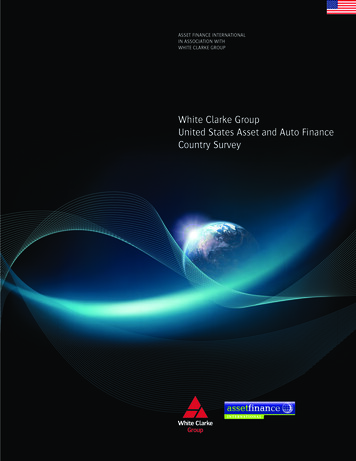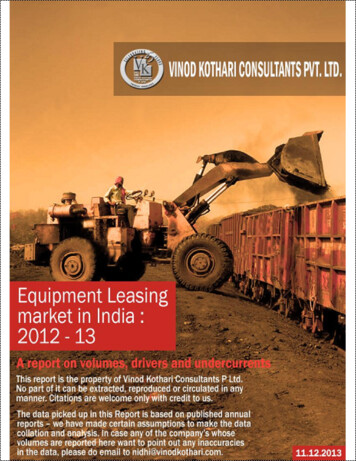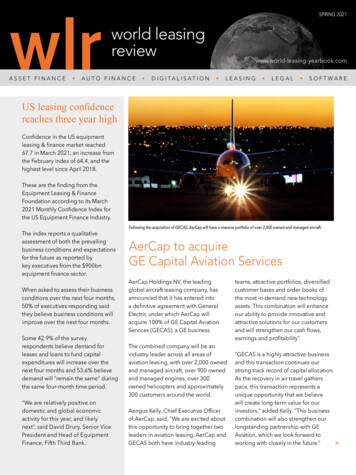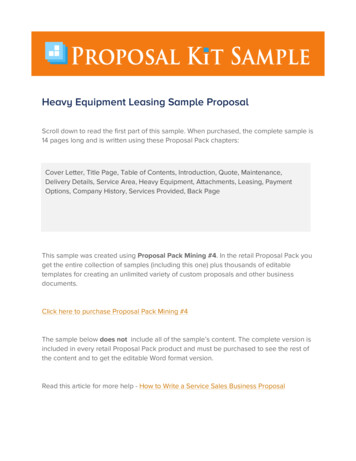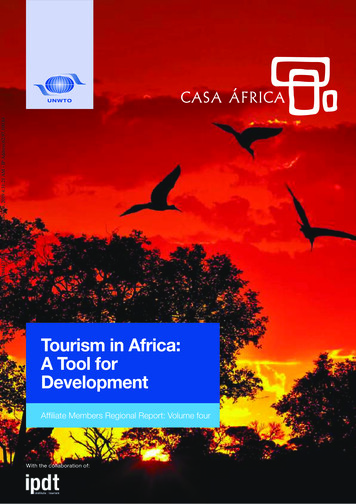
Transcription
AFRICALEASINGFACILITY IIEquipment Leasing in AfricaHandbook of Regional Statistics 2017Including an overview of 10 years ofIFC leasing intervention in the region
2017 INTERNATIONAL FINANCE CORPORATION2121 Pennsylvania Avenue, N.W., Washington, DC 20433All rights reserved.First printing, March 2018.This document may not be reproduced in whole or in part without the written consent of the International Finance Corporation.This information, while based on sources that IFC considers to be reliable, is not guaranteed as to accuracy and does not purport tobe complete.The conclusions and judgments contained in this handbook should not be attributed to, and do not necessarily represent the views ofIFC, its partners, or the World Bank Group. IFC and the World Bank do not guarantee the accuracy of the data in this publication andaccept no responsibility for any consequence of its use.Rights and PermissionsReferenceSection III. What is Leasing? and parts of Section IV. Value of Leasing in Emerging Economies are taken from IFC’s “Leasing in Development:Guidelines for Emerging Economies.” 2005, which draws upon: Halladay, Shawn D., and Sudhir P. Amembal. 1998. The Handbook ofEquipment Leasing, Vol. I-II, P.R.E.P. Institute of America, Inc., New York, N.Y.: Available from Amembal, Deane & Associates.
EQUIPMENT LEASING IN AFRICA: ACKNOWLEDGEMENTAcknowledgementThis first edition of Equipment Leasing in Africa: A handbook of regional statistics, including an overview of 10 yearsof IFC leasing intervention in the region, is a collaborative effort between IFC’s Africa Leasing Facility team and theregional association of leasing practitioners, known as Africalease.This handbook, in addition to the past ten years of IFC’s leasing work in the region, has been made possible thanks to thegenerous contributions from our donor partners: AfDB, Austria, Canada, Denmark, Ireland, Italy, Japan, Luxembourg,Netherlands, Norway, Rwanda, Spain, Sweden, Switzerland (SECO), United Kingdom, and United States.We would like to take this opportunity to thank our partners for their support in advancing the region’s leasing agenda asa means to increase access to finance for Sub-Saharan Africa’s micro, small and medium-sized businesses.We wish to further take this opportunity to extend special thanks to Switzerland’s State Secretariat for EconomicAffairs, otherwise known as SECO, for having started this journey with us and having seen it through to where weare today.
ContentsForeword1. Introduction68An innovative financing solution for those who lack collateral8World Bank Group support to leasing market development around the world8Global leasing industry9Estimating the leasing market size for movables in AfricaA 40 billion market with a twofold potential in Africa2. IFC’s Africa Leasing Facility: Ten years of leasing development across the regionALF results to date3. What is leasing?1011141718Differences between finance and operating leases20Difference between financial leasing and loans22Why is leasing different from bank financing?22Financial leases and hire purchase234. Value of leasing in emerging economies245. Testimonials to leasing26Camlease: Empowering small businesses as drivers of economic growth through leasing26Equity for Tanzania: Embracing partnership for results27Leasafric: Growing Ghana’s small business through leasing28SELFINA: Filling an economic void through leasing316. Creation of a regional leasing association: from Afrolease to Africalease327. Regional work348. Lessons learned369. Moving forward: The future of leasing in Sub-Saharan Africa4010. Country snapshots42Annex 1: Methodology used for estimating regional and national market potential for leasing126
EQUIPMENT LEASING IN AFRICA: FOREWORDForewordAccess to finance is critical for economic development. It allows businesses to grow and ultimately make importantcontributions to job creation and reduction of poverty and inequalities. However, in the developing world, 200million businesses lack access to credit. They face many hurdles that are often difficult to overcome: to access credit,they should present a credit history or some form of collateral that they often do not have.The challenge is particularly acute in much of Sub-Saharan Africa, where some 60 percent of the population isemployed in the small and medium-sized enterprise (SME) sector. This percentage is significantly higher wheninformal SMEs are included, many of which would not qualify for traditional bank financing. At SECO, we work topromote sustainable, inclusive growth and strengthen our partner countries’ resilience and response to economicand financial crises. We believe in the power of increasing access to finance to enable more business owners tocreate sustainable and successful businesses that are able to weather external shocks and create jobs.The question arises then, how best may we support small business owners in attaining the access to financenecessary to grow their businesses? One way is through improving their ability to access financial leasing.The beauty of financial leasing as a solution for many small business owners is that it eliminates the need for themto produce collateral, as the asset being leased serves as the collateral itself. Financial leasing therefore presentsitself as a tremendous opportunity for many SMEs across the continent. With a conservative market potential of 80 billion, less than half of which has been tapped, opportunities are abound on a continent with tremendousneeds for equipment in the agriculture, manufacturing and renewable energy sectors, to name a few.SECO has supported leasing around the globe and over the past decade. After country-specific support inTanzania and Ghana, SECO decided to support the IFC Africa Leasing Facility in its efforts to lay the groundworknecessary to create a sustainable leasing industry. Such efforts have included working with governmententities to draft and rework legislation and regulations to make leasing more favorable to potential players.Training government, financial and non-financial institutions, small business owners and other relevant stakeholdersin leasing has also been a large part of the equation. At the same time, the Facility has worked to empower aregional leasing association and attract finance for sustainability of such initiatives moving forward.As a result of these efforts, together we have helped put in place necessary laws and regulations, trained about24,000 relevant stakeholders, and mobilized 257 million in investments into the regional leasing sector working in25 countries on the continent, including those recovering from conflict.Creating a sustainable regional leasing market is not something that happens overnight. It is a journey requiringtime and substantial resources. But the wait and reward will be worthwhile when millions of small businessowners across the continent are able to improve their livelihoods due to the increased revenue and employmentopportunities that have arisen from leasing. Across the continent, leasing has arrived, and the time to harness itspower is now.Matthias FeldmannLiliana de Sá KirchknopfDeputy Head of MissionHead of Private Sector DivisionHead of Cooperation SECOSECOEmbassy of Switzerlandto Ghana6
7
EQUIPMENT LEASING IN AFRICA: INTRODUCTION1INTRODUCTIONAn innovative financing solution for those who lack collateralFormal small and medium-sized businesses (SMEs) contribute up to 60 percent of total employment and up to40 percent of national income, or GDP in emerging economies. These numbers are significantly higher wheninformal SMEs are included.1 One of the greatest impediments for small business owners is the lack of access tofinance necessary to procure the relevant equipment required to help expand their businesses. Many have few,if any, assets and therefore lack the collateral required by most financial institutions to secure a loan or other typesof asset financing. Leasing provides an innovative solution to this challenge.World Bank Group support to leasing market development around the worldFor over 40 years, IFC has supported leasing market development and institution building through a uniquecombination of investment and advisory products, and in partnership with technical and development partners.Over the past decade, while primarily funded with SECO support, the following donors have also supported IFC’sleasing activities in the region: AfDB, Austria, Canada, Denmark, Ireland, Italy, Japan, Luxembourg, Netherlands,Norway, Rwanda, Spain, Sweden, United Kingdom, and United States.IFC’s most pivotal role in leasing investments has been that of project catalyst. It brings together domestic sponsors,foreign technical and financial partners and, where needed, government authorities to ensure that the project iscommercially viable; organized on sound management, operating and financial principles; and will be operatedin a reasonable regulatory environment. The formulation and establishment of operating policies provide leasingcompanies with a specialized focus on industrial equipment geared mainly toward the needs of small and mediumsized borrowers.Globally, IFC has financed 239 leasing projects for 135 clients in 60 countries for a total of 1.62 billion. It has alsohelped establish or improve leasing regulations in 96 developing countries through 60 leasing advisory servicesprojects across the globe with more than 35 million of its own and donor funding. Through this experience,IFC has developed a unique expertise in policy level, institution building and leasing investment work that leveragesits strong foundation of lessons learned. As a result, governments, local private sector sponsors, foreign technicalpartners and investors see IFC’s involvement in leasing transactions as a valuable and often critical element to futureleasing market development.In recent years, regional leasing work has benefited from a new World Bank Group global practice, which has enabledthe team to leverage the full knowledge of the Group. This includes relevant World Bank secured transactions andother policy experience.Africa Leasing Facility: Increasing regional leasing sector activity since 2008On the continent, the World Bank Group’s Africa Leasing Facility has been the driving force for the introduction ofleasing since 2008. The Facility aims to create a sustainable leasing sector by helping alleviate the main challengesto growth: unfavorable legislative and regulatory environment toward leasing; lack of awareness about leasing;shortage of skills necessary to drive such market development; and insufficient financing for leasing activities.81World Bank. SME Finance Overview. Retrieved 15 Sept 2017. brief/smes-finance
INTRODUCTION1What is leasing?In its simplest form, leasing is a medium-term contract between two parties whereby one party (the lessor) providesan asset for usage to another party (the lessee) for a specified period of time in return for specified payments.It also provides a purchase option contractually agreed upon, which gives the borrower the opportunity to acquirethe rented property at a discounted price initially (residual value) taking into consideration payments alreadymade as rent. As the asset itself serves as the collateral to the financial (i.e. bank) or non-financial institution(i.e. any non-bank financial institution), the lessor is able to expand its lending portfolio to more small businessowners with viable business plans, than it would otherwise be able.Leasing therefore also provides a means for delivering increased domestic investment within economies.By developing additional financial tools such as leasing, countries are able to deepen the activities of their financialsector by introducing new products and/or industry players, thus promoting domestic production, economicgrowth, and job creation.Global leasing industryAccording to the White Clarke Global Leasing Report 2017: “For the fifth consecutive year since the globaleconomic crisis, the global leasing industry maintained an optimistic outlook and has experienced growthin new business volumes. The top 50 countries reported growth in new business volume of 6.5 percent,from 994.31 billion in 2014 to more than 1 trillion in 2015. Three regions, North America, Europe and Asia,account for more than 90 percent of total world volume.”2The report further states that in 2015, China reported an increase of 26 percent in new business volume and has“positioned itself as the second largest leasing market in the world for asset finance through leasing and hirepurchase, despite experiencing the lowest growth in GDP for the past 25 years.” Such a success story emphasizesthe important role leasing plays in helping to develop national financial markets, which will be discussed furtherlater in this handbook.Meanwhile, the Global Leasing Report 2017 concludes that Africa comprises 0.7 percent of the global leasingindustry, with four African countries falling within the ‘top 50’ leasing threshold worldwide – South Africa,Egypt, Morocco, and Nigeria. Given the lack of quantitative information available on leasing in the region,the report authors were unable to capture results from many countries in the region.2ED White, President & CEO, White Clarke Group. 2017 Global Leasing Report extracted from the Global Leasing Yearbook.9
EQUIPMENT LEASING IN AFRICA: INTRODUCTIONPercentage of Global New Business Leasing Volume (2015)Asia 22,2Europe 32,1Australia/New Zealand 3,1South America 1.4Africa 0,7North America 40,6Source: 2017 White Clarke Group Global Leasing ReportEstimating the leasing market size for movables in AfricaGiven the important role that equipment leasing plays in the development of local small and medium-sizedbusinesses, and thereby its potential to further develop national financial markets, this handbook sets out toestimate the leasing market size and potential for movables in Africa as the first step to opening up the doors forimproved dialogue, interest and enhanced information reporting and collection for the region in the future. It alsoaims to capture more inclusive amounts beyond the top regional leasing players, while serving as a reference pointfor relevant stakeholders looking to do business in the region.It is the hope that, by starting with an estimate of the regional market size and potential based upon availableinformation, the handbook will provide an inroad into focused and enhanced regional discussion on increasing andtracking leasing transactions. As more and more countries in the region begin providing established quantitativeinformation on new business leasing volumes, it will further enhance the region’s visibility globally and position itselfas a serious leasing player.10
INTRODUCTION1A 40 billion market with a twofold potential in AfricaWhile the leasing market in much of Sub-Saharan Africa has yet to be fully developed, the findings included in thishandbook estimate the continent’s leasing market volume for movables stands at almost 41 billion when takinginto account all regional leasing activity.In addition to those falling in the Top 50 in the White Clarke Global Leasing Report with respect to newbusiness volumes – South Africa, Egypt, Nigeria and Morocco – this handbook also shines light on Tunisia,which ranks among the top five regional leasing players with outstanding market sizes for movables over 1 billion in 2016. Expanding the list to the top ten players in the region by market size for movables revealsthe following countries as appear in the chart below: South Africa ( 26.79 billion), Nigeria ( 4.14 billion),Morocco ( 2.81 billion), Egypt ( 1.40 billion), Tunisia ( 1.23 billion), Algeria ( 0.50 billion), Sudan ( 0.48 billion),Angola ( 0.45 billion), Mauritius ( 0.30 billion), and Kenya ( 0.28 billion).Although the regional average volume is roughly 755 million, inclusive of South Africa, it decreases to 260 million when South Africa is taken out of the equation, and falls as low as 80 million when the top fivecountries by market size – South Africa, Nigeria, Morocco, Egypt, and Tunisia – are taken out of the picture.Top 10 Countries in Africa by Leasing Market Size for Movables (2016)40Market size ( billion)Potential ( riaTunisiaEgyptMoroccoNigeriaSouth Africa011
EQUIPMENT LEASING IN AFRICA: INTRODUCTIONMeanwhile, conservative estimates place regional potential at about 83 billion.3 The top five countries with the greatestleasing potential contribute to more than three quarters that amount: South Africa ( 35.60 billion), Nigeria ( 12.67billion), Egypt ( 8.76 billion), Morocco ( 4.41 billion), Algeria ( 4.27 billion), Tunisia ( 1.98 billion), Angola ( 1.63 billion),Côte d’Ivoire ( 1.06 billion), Ethiopia ( 1.05 billion) and Sudan ( 1.03 billion).The average regional leasing market potential is about 1.5 billion. It decreases to 880 million when South Africa isnot included, and down to about 320 million when the top five countries for potential - South Africa, Nigeria, Egypt,Morocco, Algeria – are taken out of the equation.Top 10 Countries in Africa by Leasing Potential (2016)40Potential ( billion)Market size ( billion)3530252015105SudanEthiopiaCôte outh Africa0Future of Africa’s leasing market developmentAs a favorable legislative and regulatory environment for leasing has been established in many of the region’s countrieswhetting the appetite for local leasing development, investors are taking notice. Given the region’s leasing potential,those joining the leasing movement today are likely to see considerable rewards.3Estimates based upon an average of three globally recognized ways of calculating leasing potential – as a percentage of: GDP, capital goods imports,and gross fixed capital formation. See Annex 1 for a description of full methodology. Rates have been adjusted based upon national leasing maturity12and are specified when differ from the example in Annex 1.
INTRODUCTION113
EQUIPMENT LEASING IN AFRICA: IFC’S AFRICA LEASING FACILITY: TEN YEARS OF LEASING DEVELOMENT ACROSS THE REGION2IFC’S AFRICA LEASING FACILITY:TEN YEARS OF LEASING DEVELOPMENTACROSS THE REGIONIFC launched the Africa Leasing Facility (ALF I) in 2008 to build upon successes of previous individual IFC leasinginterventions in Ghana, Madagascar, Rwanda and Tanzania, which facilitated increased access to finance for micro,small and medium-sized enterprises (MSMEs) in select countries by developing a sustainable leasing infrastructure.Following the success of the fourteen country engagement, the Africa Leasing Facility II (ALF II) was launched in2013 to further the region’s leasing development.ALF II (2014): Burundi, Côte d’Ivoire, Dijibouti, Ethiopia, Guinea, Guinea Bissau, Liberia, Mali,Niger, Rwanda, Seychelles, Sierra Leone, Somaliland, Sudan, Uganda, WAEMU.ALF I (2008): Burkina Faso, Cameroon, Cape Verde, DRC, Ghana, Guinea, Liberia,Madagascar, Mali, Mauritiana, Rwanda, Senegal, Sierra Leone, Tanzania.Pre-ALF countries (standalone programs pre-2008):Ghana, Madagascar, Rwanda, Tanzania.14
IFC’S AFRICA LEASING FACILITY: TEN YEARS OF LEASING DEVELOMENT ACROSS THE REGION2Since its inception, IFC’s Africa Leasing Facility has aimed to facilitate access to finance for small and mediumenterprises through the development of a sustainable leasing industry. It has done this by working at the regulatory,financial institution, market and firm levels. Specifically, ALF works to:Ŝ help promote leasing friendly legislative and regulatory reforms (regulatory level);Ŝ provide leasing business advisory support to financial and non-financial institutions, and in doing so, contributeto the increase of leasing transactions (financial institutions level);Ŝ build capacity in market stakeholders to continue the development of leasing upon program completion(market level);Ŝ strengthen the awareness and capacity of select SMEs to access leasing financing as a way to meet theirequipment needs and make them more economically viable and active (firm level);Ŝ create a sustainable leasing sector by working with business associations and stakeholders to establish strongleasing networks driven by regional and national leasing associations; andŜ mobilize investment capital in leasing.ResultsStrong track record in leasing investments and advisory servicesUnique expertise on policy level, institution building and leasing investment work5024,000 257mLeasing laws and regulationsRepresentatives of MSMEs,Investment capitaladopted with IFC assistancegovernment, Fls andmobilizednon-Fls trainedThe objective of ALF II is to facilitate increased access to finance for micro, small and medium enterprises (MSMEs)in fragile states, by developing a sustainable leasing infrastructure to promote this sector.15
EQUIPMENT LEASING IN AFRICA: IFC’S AFRICA LEASING FACILITY: TEN YEARS OF LEASING DEVELOMENT ACROSS THE REGIONPromoting leasing friendly legislative and regulatory reformsOften one of the first mandates of ALF is to work with the relevant local legal, tax and regulatory agencies (such asthe ministries of finance, central banks, judiciary) to help alleviated regulatory constraints to future development,competiveness, and sustainability of the leasing sector. IFC advises government partners on ways laws and/orregulations may be revised to provide remedies and enforcement of contract compliance by all the parties toa lease transaction (lessor, lessee, supplier). For example, revised legislation may enhance the attractiveness tosector investment by reducing potential risks through the establishment of a collateral registry or strengtheningrepossession rights. Another example, is the introduction of a tax reform which exempts all equipment financingrelated to a particular sector to build confidence in the market.Providing leasing business advisory services to support financial and non-financial institutionsALF works with financial (such as commercial banks) and non-financial institutions (such as leasing or microfinancecompanies) to help employees understand leasing, from how it is structured to how to perform a leasing transaction.For those institutions looking to increase their capital base, ALF also provides guidance to help them become eligiblefor lines of credit. Meanwhile, ALF’s leasing handbooks provide a reference for stakeholders operating within and/orthose interested in leasing. At the MSME level, ALF also provides consumer education directly to potential clients inconjunction with local financial and non-financial institutions.Building capacity in market stakeholders (lessees, lessors, regulators and local and regionalleasing associations)IFC supports increasing awareness of leasing as an alternative form of financing. It does this by supporting localand regional leasing forums and leasing associations, in addition to creating educational materials for distribution.ALF intervention also entails capacity building of current and/or future regulators and lessors to enhance theirknowledge of the leasing product to enable them to either improve legislation and regulations which supportleasing and/or help create the proper framework within their finance or non-finance institution to offer leasing.It further animates trainings directly to small business owners which introduce them to the power of leasing.Strengthening awareness and capacity of select SMEs to access lease financingALF also works with small business owners who have shown a capacity and desire to expand their leasing servicesand further educate others about leasing. Dr Victoria Kisyombe, founder of Sero Lease and Finance Ltd (SELFINA)in Tanzania, is one such business owner with whom IFC has built a relationship. In 2002, Dr Kisyombe openedher business in Dar es Salaam and began loaning and leasing productive assets. ALF provided in-depth advisoryservices to SELFINA on how to improve its leasing operations. As a result, SELFINA was able to obtain a 1 millioncredit line from IFC through Exim Tanzania Ltd. ALF further helped train SELFINA’s beneficiaries with respect toleasing basics, such as the general concept, consequence of default, etc. According to SELFINA’s website, “In the past11 years SELFINA has economically empowered more than 25,000 women with a total credit worth 16 million.Over 200,000 lives have been impacted through the benefits accrued. Women are now owners of their ownbusinesses and more than 150,000 jobs have been created.” This is the power of leasing.16
IFC’S AFRICA LEASING FACILITY: TEN YEARS OF LEASING DEVELOMENT ACROSS THE REGION2Mobilizing investment capital in leasingFor many financial institutions, leasing is capital intensive. As such, launching leasing operations is often prohibitiveto many regional financial institutions that do not meet national minimal capital requirements for leasing.IFC works with local and international investors and donors to help attract investment into the leasing sector.In Ghana, for example, IFC helped mobilize an additional 5 million for the leasing sector. Following the team’ssupport, AMAL Bank (now Bank of Africa) and Leasafric Ghana Limited (Leasafric) received lines of credit for 2 million and 1.5 million respectively from Netherlands-based Oiko Credit – a global cooperative and socialinvestor, which provides funding to the microfinance sector, fair trade organizations, cooperatives and small tomedium enterprises. Following a solid relationship built between Oiko Credit and Leasafric, Leasafric then went onto apply for and receive an additional 1.5 million in financing.ALF results to dateSince 2008, IFC’s Africa Leasing Facility has:Ŝ helped the enactment of 50 leasing laws or regulations in the following countries: Burundi, Burkina Faso, Chad,Cameroon, Comoros, Côte d’Ivoire, Djibouti, DRC, Ethiopia, Ghana, Guinea, Liberia, Madagascar, Mali, Niger,Rwanda, Senegal, Sierra Leone and Tanzania;Ŝ trained 24,000 representatives of MSMEs, government, financial institutions and non-financial institutions; andŜ mobilized US 257 million in investments into the SSA leasing sector.17
EQUIPMENT LEASING IN AFRICA: WHAT IS LEASING?3WHAT IS LEASING?Leasing in its simplest form is a means of delivering finance, with leasing broadly defined as “a contract betweentwo parties where one party (the lessor) provides an asset4 for usage to another party (the lessee) for a specifiedperiod of time, in return for specified payments.5” Leasing, in effect, separates the legal ownership of an asset fromthe economic use of that asset.Leasing is a medium-term financial instrument for the procurement of machinery, equipment, vehicles,and/or properties. Leasing provides financing of assets – equipment, vehicles – rather than direct capital.Leasing institutions (lessors) – banks, leasing companies, insurance companies, equipment producers or suppliers,and non-bank financial institutions–purchase the equipment, usually as selected by the lessee, providing theequipment for a set period of time to businesses. For the duration of the lease, the lessee makes periodic paymentsto the lessor according to an agreed upon payment schedule. At the end of the lease period, the equipment is eithertransferred to the ownership of the lessee/business, a secondary lease, returned to the lessor, or sold to a third party.Under financial leasing, the lessee typically acquires or retains the asset.Leasing is based on the proposition that profits are earned through the use of assets, rather than from theirownership. It focuses on the lessee’s ability to generate cash flow from business operations to service the leasepayment, rather than on the balance sheet or past credit history. This is why leasing is particularly advantageousfor new, small and medium-size businesses that do not have a lengthy credit history or a significant asset base forcollateral. Furthermore, the lack of a collateral requirement with leasing offers an important advantage in countrieswith weak business environments, particularly those with weak creditors’ rights and collateral laws and registries,for instance, in countries where secured lenders do not have priority in the case of default.It should be noted that, to date, IFC has focused mainly on the development of financial leasing. This is the primarystage in leasing development in most emerging and transitional economies. Operating leases (or rental) can be equallyimportant in the long term, but for a number of reasons are generally typical of a later stage of development.184IFC’s work focuses primarily on equipment leases. The term ‘asset’ in this booklet therefore refers to equipment and/or vehicles.5IFC’s “Leasing in Development: Guidelines for Emerging Economies.” 2005, which draws upon: Halladay, Shawn D., and Sudhir P. Amembal. 1998.The Handbook of Equipment Leasing, Vol. I-II, P.R.E.P. Institute of America, Inc., New York, N.Y.: Available from Amembal, Deane & Associates.
WHAT IS LEASING?319
EQUIPMENT LEASING IN AFRICA: WHAT IS LEASING?A finance lease is a contract that allows the lessor, as owner, to retain ownership of an asset while transferringsubstantially all the risks and rewards of ownership to the lessee.6 A finance lease is also known as a full payoutlease, because rent paid during the term of the lease depreciates the cost of purchasing the asset plus the borrower’smargin (there may be a nominal value/fees payable by the lessee). The payments also cover the lessor’s fundingcosts and provide a profit. Despite the legal form of the transaction, the economic substance of a finance leasetransaction is one of purchase financing rather than a mere rental.In contrast, an operating lease is essentially a rental contract for, usually, the short-term or temporary use of
This first edition of Equipment Leasing in Africa: A handbook of regional statistics, including an overview of 10 years of IFC leasing intervention in the region, is a collaborative e!ort between IFC's Africa Leasing Facility team and the regional association of leasing practitioners, known as Africalease.
